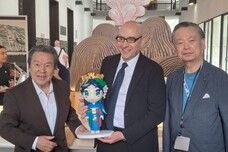Vitamin B2, activated charcoal and
Nori are just some of the components of the first rechargeable
and fully edible battery created at the Italian Institute of
Technology (IIT) in Milan, Italy, and described in the journal
Advanced Materials.
The prototype saw the light of day in the IIT's Molecular
Electronics Laboratory directed by Mario Caironi with funding
from the European Research Council (ERC). Co-author of the study
is Ivan Ilic, from the same laboratory.
The battery is the first concrete expression of the recently
growing field of research into edible electronics. In the
future, such batteries could be used to power diagnostic
instruments or to monitor food quality, or even to power future
edible robots.
The battery is composed of riboflavin, known as vitamin B2,
which acts as the anode, and quercetin, found in almonds and
capers, which acts as the cathode. Activated charcoal has been
used to increase electrical conductivity, while in this
prototype the electrolyte is water-based.
The separator, needed in every battery to avoid short circuits,
is made from Nori seaweed, commonly used to make sushi. Lastly,
electrodes are encapsulated in beeswax from which two food-grade
gold contacts (the foil used by pastry chefs) on a cellulose
derived support come out.
ALL RIGHTS RESERVED © Copyright ANSA










